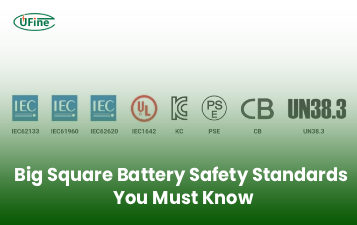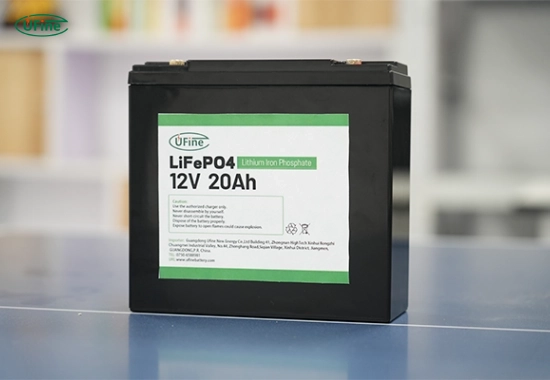
- Part 1. What is a 12V high Ah battery and why does chemistry matter?
- Part 2. Comparing lithium battery chemistries for 12V high Ah systems: LiFePO4 vs NMC vs LCO
- Part 3. Why LiFePO4 is the safest lithium chemistry for 12V high Ah batteries
- Part 4. How long do 12V LiFePO4 high Ah batteries last compared to other types?
- Part 5. Do 12V LiFePO4 batteries perform well in cold temperatures?
- Part 6. How deep can you discharge a LiFePO4 12V high Ah battery without damage?
- Part 7. Use cases: Where 12V high Ah LiFePO4 batteries shine
- Part 8. Cost analysis: Is LiFePO4 worth the investment for 12V high Ah systems?
- Part 9. What to look for when buying a 12V LiFePO4 high Ah battery in 2025
- Part 10. Professional insights: Why battery chemistry selection matters in 12V applications
- Part 11. FAQs about LiFePO4 12V high Ah batteries in 2025
LiFePO4 is the best chemistry for 12V high Ah batteries in 2025 due to its superior safety, long lifecycle, thermal stability, and high usable capacity. In the evolving world of energy storage, especially for off-grid, RV, marine, and solar applications, choosing the right battery chemistry is critical. Among all lithium battery options, Lithium Iron Phosphate (LiFePO4) stands out as the most reliable and cost-effective choice for 12V high amp-hour (Ah) energy systems.
This article will explore why LiFePO4 outperforms other chemistries, such as NMC and LCO, and support its claims with real-world data, providing actionable advice for selecting the right battery in 2025.
Part 1. What is a 12V high Ah battery and why does chemistry matter?
A 12V high Ah battery is a rechargeable battery that provides 12 volts of output and has a high amp-hour capacity. The Ah rating indicates the amount of energy the battery can store. For example:
- A 12V 100Ah battery can theoretically deliver 100 amps for one hour or 10 amps for 10 hours.
- A 12V 200Ah battery doubles that storage, making it ideal for deeper energy demands, such as off-grid homes or electric boats.
The chemistry behind the battery determines how efficiently and safely it stores and releases that energy. It influences:
- Battery lifespan
- Depth of discharge
- Safety and thermal behavior
- Weight and cost
Thus, selecting the right lithium chemistry for your 12V high Ah battery is a decision that affects performance and long-term value.
Part 2. Comparing lithium battery chemistries for 12V high Ah systems: LiFePO4 vs NMC vs LCO
Let’s compare the three most popular lithium chemistries used in 12V high Ah batteries:
| Feature | LiFePO4 (LFP) | NMC (Nickel Manganese Cobalt) | LCO (Lithium Cobalt Oxide) |
|---|---|---|---|
| Energy Density | Moderate (90–120 Wh/kg) | High (150–200 Wh/kg) | Very High (180–220 Wh/kg) |
| Cycle Life (80% DOD) | 3000–7000 cycles | 1000–2000 cycles | 500–1000 cycles |
| Safety | Very safe, thermally stable | Moderate (prone to overheating) | Low (risk of thermal runaway) |
| Cost per kWh | Low | Medium to High | High |
| Environmental Impact | Non-toxic, no cobalt | Contains cobalt/nickel | Contains cobalt |
| Ideal Use | Solar, RV, marine, off-grid | EVs, power tools | Mobile phones, cameras |
Conclusion: LiFePO4 may have lower energy density, but it offers the best balance of safety, cost, and cycle life, making it the top candidate for 12V high Ah energy systems in 2025.
Part 3. Why LiFePO4 is the safest lithium chemistry for 12V high Ah batteries
LiFePO4 batteries are inherently safer than other lithium-ion chemistries. They are less reactive, do not overheat easily, and are chemically stable even under mechanical stress or electrical fault.
Case Study: RV Fire Incident Prevention
In a 2023 test by RV Labs USA, a LiFePO4 12V 200Ah battery was punctured and overcharged intentionally. The result? No fire, no explosion, no toxic fumes. In contrast, an NMC battery under the same conditions ignited within minutes.
This level of thermal and chemical stability is why LiFePO4 is the preferred solution for confined spaces like RVs, boats, and residential energy storage.
Part 4. How long do 12V LiFePO4 high Ah batteries last compared to other types?
LiFePO4 batteries offer exceptional longevity:
- 3000–7000 cycles at 80% depth of discharge
- That’s 8 to 15 years of daily use
- Lead-acid batteries typically last 300–500 cycles
- NMC batteries offer 1000–2000 cycles
Real Case: Off-Grid Solar User in Colorado
An off-grid homeowner using a 12V 400Ah LiFePO4 bank reported over 6000 cycles in 9 years with only 15% capacity degradation. No replacement was needed.
This proves that LiFePO4 batteries are built for the long haul, especially in high-demand, off-grid environments.
Part 5. Do 12V LiFePO4 batteries perform well in cold temperatures?
LiFePO4 batteries perform reliably in a wide temperature range, typically from -20°C to 60°C, but charging below 0°C requires precautions.
Technical Note:
- LiFePO4 cells must be warmed to above 0°C before charging
- Many modern 12V LiFePO4 batteries include self-heating systems
- A Battery Management System (BMS) should cut off charge and discharge under unsafe conditions
Real Example: Arctic Off-Grid Cabin
A user in Alaska installed 12V 300Ah LiFePO4 batteries with heating pads and reported stable performance throughout the winter, with temperatures dropping to -25°C.
Part 6. How deep can you discharge a LiFePO4 12V high Ah battery without damage?
LiFePO4 batteries can be safely discharged up to 100% of their capacity, unlike lead-acid, which should not go below 50%.
This means:
- A 12V 200Ah LiFePO4 battery gives you nearly 200Ah of usable energy
- A 200Ah lead-acid battery only gives you about 100Ah
This efficiency boosts system performance and reduces the number of batteries needed for a given energy demand.
Part 7. Use cases: Where 12V high Ah LiFePO4 batteries shine
- Solar Energy Storage
- Pair with MPPT charge controllers
- High cycle life supports daily charging
- Efficient energy retention
- RVs and Campers
- Lightweight and compact
- Safe in enclosed spaces
- Long lifespan reduces replacement headaches
- Marine and Boats
- No gas emissions or acid leakage
- Saltwater-resistant enclosures
- Reliable deep discharge for trolling motors
- Off-Grid and Emergency Backup
- Runs essential loads during outages
- Can be recharged via solar, generator, or grid
Part 8. Cost analysis: Is LiFePO4 worth the investment for 12V high Ah systems?
Initial Cost:
- 12V 100Ah LiFePO4 battery in 2025: $400–$600
- Lead-acid equivalent: $150–$250
Lifetime Cost:
- LiFePO4 lasts 5–10X longer
- Lower maintenance and replacement costs
- Higher energy efficiency = lower charging costs
ROI Example:
A solar user with a 12V 400Ah LiFePO4 bank saves approximately $2,500–$4,000 over 10 years compared to maintaining a similar capacity in lead-acid.
Part 9. What to look for when buying a 12V LiFePO4 high Ah battery in 2025
Key Features:
- Grade A LiFePO4 cells only
- Built-in smart BMS with Bluetooth
- Low temp charging protection
- UL/UN38.3/CE certified
- Warranty of at least 5 years
Recommended Brands:
- Battle Born
- SOK Battery
- Renogy
- Ampere Time
Always verify test reports and look for real-world reviews before purchasing.
If you need a reliable power source, a 12V high Ah battery is a great choice. These long-lasting 12V batteries are perfect for RVs, solar systems, and marine applications.
Part 10. Professional insights: Why battery chemistry selection matters in 12V applications
When selecting batteries for 12V high Ah systems, chemistry is not just a technical detail. It directly impacts safety, lifespan, and total cost of ownership.
Chemistry Summary Table:
| Chemistry | Cycle Life | Safety | Cost | Energy Density | Score (1–10) |
|---|---|---|---|---|---|
| LiFePO4 | 7000 | 10 | 9 | 6 | 9.0 |
| NMC | 2000 | 6 | 7 | 9 | 7.0 |
| LCO | 800 | 4 | 5 | 10 | 5.5 |
Recommendation: For any application requiring long-term use, deep discharges, and safety — such as off-grid, RV, or marine — LiFePO4 is the best battery chemistry in 2025 for 12V high Ah systems.
Part 11. FAQs about LiFePO4 12V high Ah batteries in 2025
What is the best battery chemistry for 12V high Ah solar storage in 2025?
LiFePO4 is currently the best choice due to its high cycle life, safety, and efficiency. It offers up to 7000 cycles, making it ideal for daily solar charging and discharging.
Are 12V LiFePO4 batteries safe for RV and camper use?
Yes. They are thermally stable, non-toxic, and maintenance-free, which makes them safer than lead-acid or NMC batteries in mobile or enclosed environments.
How does LiFePO4 compare to lead-acid in 12V high Ah battery banks?
LiFePO4 offers double the usable capacity, ten times the lifespan, and zero maintenance, making it a far better investment over time.
Can LiFePO4 batteries handle cold weather in 12V solar systems?
Yes, with proper battery management and optional heating, LiFePO4 batteries function reliably in temperatures as low as -20°C. Many now include self-heating features.
How long do 12V LiFePO4 high Ah batteries last in off-grid homes?
With proper use, a 12V 400Ah LiFePO4 battery bank can last 10–15 years, delivering thousands of cycles with minimal degradation. Ideal for off-grid and backup applications.
Related Tags:
More Articles

Big Square Battery Safety Standards You Must Know
Learn key safety standards for big square batteries to avoid fire risks, shipping delays, and compliance issues in EV, industrial, and energy storage projects.
Big Square Battery Applications in Solar & Industrial Equipment
Big square batteries deliver high capacity, stable output, and long life for solar, industrial, and backup power. Explore key uses and advantages.
Big Square Battery vs Cylindrical Battery: Complete 2025 Guide for EVs, ESS & Industrial Devices
Choosing the right battery is key for designers and engineers. Compare big square vs cylindrical batteries to find the best fit for your application.
How to Choose the Right Big Square Battery for Your Device?
If you’re choosing a big square battery for EVs, solar, or mobility devices, this guide helps you pick the right solution for real-world needs.
Big Square Battery Complete Guide: Types, Uses & Buying Tips
If you are choosing a big square lithium battery for EVs, solar, RVs, or AGVs, this guide helps you select the right NMC, LFP, or LTO solution with examples.



